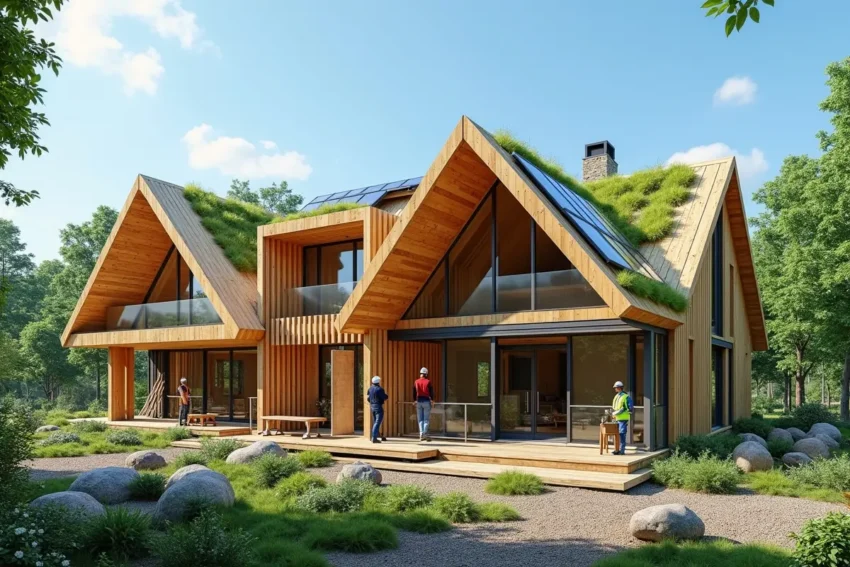The landscape of residential construction is transforming rapidly as awareness of environmental issues and the desire for healthier living spaces continue to grow. In 2025, sustainable practices are not just an option—they are fast becoming the industry standard, as both builders and homeowners value green solutions for their environmental and economic benefits.
Trends such as net-zero homes, innovative sustainable materials, and integrated smart technologies are significantly shaping how new residences are planned and constructed. If you’re seeking sustainable solutions, experienced specialists like home builders Lancaster, PA, stand out for their focus on green designs and modern comfort.
Sustainability in modern homes now extends beyond lowering energy bills to encompass the entire building lifecycle, from site selection to finishes. By using innovative materials, automation, biophilic design, and efficient water management, homes become eco-friendly while enhancing comfort, quality of life, and connection to nature.
Driven by homeowners’ interest in energy efficiency, indoor health, and smart technology, green homes also boost property value, reduce operating costs, and lessen environmental impact. With growing government incentives and stricter sustainability standards, both new builds and renovations are increasingly focused on minimizing waste and maximizing performance.
Innovative Building Materials
Material innovation is at the core of sustainable home construction. Builders are opting for renewable resources like bamboo, rapidly recycled materials such as steel, and natural alternatives like rammed earth or hempcrete. These choices minimize the environmental toll of extracting and processing traditional building supplies.
For homeowners looking to integrate these eco-friendly methods, partnering with custom home builders Montgomery County, PA, ensures that sustainable materials are used thoughtfully and effectively throughout the project. For example, recycled steel beams help reduce the significant energy and emissions associated with producing new metal, while bamboo offers rapid regrowth and natural strength for flooring and structural elements. Such materials meet stringent green standards while lending a distinctive modern appeal to interiors and exteriors.
Net-Zero Energy Homes
Net-zero energy homes represent a pinnacle of sustainable construction. These residences are designed to generate as much renewable energy—often via solar panels or geothermal systems—as they consume annually, drastically reducing homeowners’ energy expenses and overall carbon footprints.
Advances in building science, insulation, and airtight construction are making it easier for architects and contractors to deliver truly net-zero living environments. The Department of Energy reports that adoption of net-zero homes has accelerated due to stricter codes and increased incentives in many states, supporting both long-term cost savings and a healthier planet.
Smart Home Technologies
Integrating smart technology is now central to sustainable living. Today’s best home automation systems employ artificial intelligence and real-time data to regulate lighting, climate, ventilation, and even window shading for optimal energy efficiency.
Homeowners can monitor appliances and systems remotely to reduce energy waste, and sensors can automatically adjust indoor temperature and lighting based on occupancy and natural light. Innovations like adaptive thermostats and AI-powered security systems provide both comfort and efficiency and can substantially lower household operating costs over time.
Biophilic Design
Biophilic design integrates nature into built environments to foster health and well-being. This trend is evident in features such as living green walls, indoor gardens, abundant daylighting, and the use of organic shapes and natural materials. According to experts at MasterClass, biophilic design not only creates visually appealing spaces but also actively promotes mental and physical wellness by bringing the outdoors inside.
The result is a calming, harmonious atmosphere that research shows can reduce stress, elevate mood, and boost cognitive performance. Biophilic homes often feature expansive windows for nature views, natural ventilation strategies, and spaces designed to encourage outdoor living, all of which strengthen residents’ lifelong connection to the environment.
Water Conservation Measures
With water scarcity becoming a central concern, modern sustainable homes prioritize water efficiency through multiple strategies. Installing low-flow toilets, showerheads, and faucets, as well as smart irrigation systems and drought-resistant landscapes, minimizes water usage without sacrificing comfort.
Greywater recycling captures and reuses water from sinks and baths for garden or non-potable uses, further conserving resources. These measures are especially significant in arid zones or regions affected by recurring droughts, ensuring homes remain resource-responsible for the long term.
Sustainable construction is redefining what it means to build—and live—in a modern home. By adopting these forward-thinking trends, new homeowners and builders are helping to create a more resilient, efficient, and harmonious environment for generations to come.

